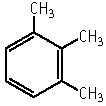

Additional toxicity testing at doses of 0, 3, 10, 30 mg, did not reveal any substance related changes in terms of blood coagulation examination. Therefore, the NOEL for the repeat dose toxicity is considered to be 30 mg/kg/day for both sexes.
1,2,3-Trimethylbenzene was not mutagenic to Salmonella typhimurium, TA100, TA1535, TA98, TA1537 and Escherichia coli WP2 uvrA, with or without an exogeneous metabolic activation system.
1,2,3-Trimethylbenzene slightly increased incidences of structural chromosomal aberrations with an exogeneous metabolic activation system.
| Purity | : | 99.8% |
| Test species/strain | : | Rat/Crj:CD (SD) |
| Test method | : | Guidelines for 28-day Repeated Dose Toxicity Testing of Chemicals (Japan) |
| Route | : | Oral |
| Doses | : | 0 (vehicle), 100, 300, 1000mg/kg/day |
| Number of animals/group | : | Males, 5 ; females, 5 |
| Administration period | : | Males and females, 28 days |
| Terminal kill | : | Males and females, days 29 or 43 |
| GLP | : | Yes |
Test results:
| Purity | : | 99.8% |
| Test species/strain | : | Rat/Crj:CD (SD) |
| Test method | : | Guidelines for 28-day Repeated Dose Toxicity Testing of Chemicals (Japan) |
| Route | : | Oral |
| Doses | : | 0 (vehicle), 3, 10, 30 mg/kg/day |
| Vehicle | : | Corn oil |
| Number of animals/group | : | Males, 5 ; females, 5 |
| Administration period | : | Males and females, 28 days |
| Terminal kill | : | Males and females, days 29 |
| GLP | : | Yes |
Test results:
| Purity | : | 90.8% |
| Test species/strains | : | Salmonella typhimurium TA100, TA1535, TA98, TA1537, E. coli WP2 uvrA |
| Test methods | : | Guidelines for Screening Mutagenicity Testing of Chemicals (Japan) |
| Procedures | : | Pre-incubation method |
| Solvent | : | DMSO |
| Positive controls | : | -S9 mix AF-2 (TA100, TA98 and WP2 uvrA) Sodium azide (TA1535) 9-Aminoacridine (TA1537)
+S9 mix 2-Aminoanthracene (all strains) |
| Doses | : | -S9 mix (all strains) 1.42, 2.84, 5.68, 11.4, 22.7, 45.4 μg/plate
+S9 mix (TA100, TA1535 and TA1537) 1.42, 2.84, 5.68, 11.4, 22.7, 45.4 μg/plate +S9 mix (TA98 and WP2 uvrA) 5.68, 11.4, 22.7, 45.4, 90.8, 182 μg/plate |
| S9 | : | Rat liver, induced with phenobarbital and 5,6-benzoflavone |
| Plates/test | : | 3 |
| Number of replicates | : | 2 |
| GLP | : | Yes |
Test results:
| + | ? | - | |
| without metabolic activation: | [ ] | [ ] | [*] |
| with metabolic activation: | [ ] | [ ] | [*] |
| + | ? | - | |
| without metabolic activation | [ ] | [ ] | [*] |
| with metabolic activation | [ ] | [ ] | [*] |
| Purity | : | 90.8% |
| Type of cell used | : | Chinese hamster lung (CHL) cells |
| Test method | : | Guidelines for Screening Mutagenicity Testing of Chemicals (Japan) |
| Solvent | : | DMSO |
| Positive controls | : | long-term treatment; Mitomycin C (24 h and 48 h) short-term treatment; Cyclophosphamide (+S9 and -S9 mix) |
| Doses | : | long-term treatment; 90.0, 180, 360 μg/ml (24 h)
long-term treatment; 60.0, 120, 240 μg/ml (48 h) short-term treatment; 120, 240, 480, 960 μg/ml (+S9 mix) short-term treatment; 120, 240, 480 μg/ml (-S9 mix) |
| S-9 | : | Rat liver, induced with phenobarbital and 5,6-benzoflavone |
| Plates/test | : | 2 |
| GLP | : | Yes |
Test results:
| clastogenicity | polyploidy | |||||
| + | ? | - | + | ? | - | |
| without metabolic activation: | [ ] | [ ] | [*] | [ ] | [ ] | [*] |
| with metabolic activation: | [ ] | [*] | [ ] | [ ] | [ ] | [*] |
| 1) | The tests were performed by the Biosafety Research Center, Foods, Drugs and Pesticides (An-pyo Center), Japan, 582-2 Shioshinden Arahama, Fukude-cho, Iwata-gun, Shizuoka, 437-12, Japan. Tel +81-538-58-1266 Fax +81-538-58-1393 |